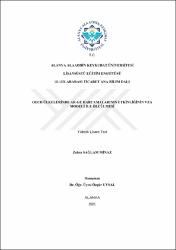OECD ülkelerinde ar-ge harcamalarının etkinliğinin VZA modeli ile ölçülmesi
Özet
Teknoloji ve bilişim teknolojilerinin hızla değiştiği ve geliştiği bu çağda, ülkelerin bu değişimleri zamanında yakalaması veya teknolojik gelişmelere öncülük etmesi, küreselleşen dünyada rekabet üstünlüğü sağlaması açısından önemli bir konudur. Bu değişim ve gelişim için Ar-Ge faaliyetleri ülkeler için kritik öneme sahiptir. Yapılan Ar-Ge faaliyetleri ile ülkeler, hem refah düzeyini artırmakta hem de küresel piyasalardaki sert rekabet koşullarına ayak uydurarak istikrarı sağlamaktadırlar. Ar-Ge faaliyetlerin etkinliği bu aşamada ülkeler için yol gösterici konumundan dolayı büyük önem taşımaktadır. Ar-Ge harcamalarının etkinliği, hangi alanlara daha fazla bütçe ayrılması gerektiği ve hangi alanlarda iyileştirmeler yapılması gerektiğini ifade etmektedir. Bu çalışmanın amacı, OECD ülkelerinin Ar-Ge harcamalarının etkinliğini 2015- 2017 dönemi kapsamında; Akademik Etkinlik ve Teknolojik Etkinlik olmak üzere iki model şeklinde analiz etmektir. Buradan hareketle "Hangi OECD ülkelerinin Ar-Ge harcamaları akademik ve teknolojik açıdan etkindir?" sorusuna cevap aranmıştır. Analiz yöntemi için Charnes vd. (1978) ve Banker vd. (1984) tarafından geliştirilen Veri Zarflama Analizi modellerinden CCR ve BCC modelleri tercih edilmiştir. Analizler DEAP 1.3.0 yazılım programı aracılığıyla gerçekleştirilmiştir. 30 OECD ülkesinden oluşan Karar Verme Birimleri için Model-1 kapsamında girdi değişkenleri; Ar-Ge harcamalarının GSYİH içindeki payı ve 1000 kişiye düşen araştırmacı sayısı, çıktı değişkenleri; IP5 patent sayıları ve bilimsel yayın sayıları, Model-2 kapsamında girdi değişkenleri; Ar-Ge harcamalarının GSYİH içindeki payı ve 1000 kişiye düşen araştırmacı sayısı, çıktı değişkenleri; IP5 patent sayıları ve yüksek teknolojili ürün ihracatının toplam ihracat içindeki payıdır. Çalışmanın sonucuna göre, Model-1 Akademik Etkinlik kapsamında 2015-2017 dönemi CCR ve BCC modeli baz alınarak yapılan etkinlik analizi sonucunda, Japonya ve ABD'nin her iki modelde de etkin olduğu gözlemlenmiştir. Model-2 Teknolojik Etkinlik kapsamında 2015-2017 dönemi CCR ve BCC modeli baz alınarak yapılan etkinlik analizi sonucunda ise Japonya ve Meksika'nın her iki modelde de etkin olduğu saptanmıştır.
In this age where technology and information technologies change and develop rapidly, it is an important issue for countries to catch up with these changes in time or to lead technological developments in terms of providing competitive advantage in the globalizing world. R&D activities are critical for countries for this change and development. With the R&D activities carried out, countries both increase the level of welfare and ensure stability by keeping up with the harsh competition conditions in the global markets. The effectiveness of R&D activities is of great importance at this stage due to its guiding position for countries. The effectiveness of R&D expenditures indicates which areas should be allocated more budget and in which areas improvements should be made. In addition, measuring the effectiveness of R&D expenditures facilitates the comparison of countries with each other. The aim of this study is to analyze the efficiency of R&D expenditures of OECD countries within the scope of 2015-2017; To analyze in two models, Academic Effectiveness and Technological Efficiency. From this point of view, "Which OECD countries' R&D expenditures are academically and technologically efficient?" The answer to the question has been sought. For the analysis method, Charnes et al. (1978) and Banker et al. (1984) Data Envelopment Analysis models developed by CCR (CRS) and BCC (VRS) models were preferred. Analyzes were performed using the DEAP 1.3.0 software program. Input variables under Model-1 for Decision-Making Units consisting of 30 OECD countries; Share of R&D expenditures in GDP and number of researchers per 1000, output variables; IP5 patent numbers and scientific publication numbers, input variables within the scope of Model-2; Share of R&D expenditures in GDP and number of researchers per 1000, output variables; IP5 is the number of patents and the share of high-tech product exports in total exports. According to the results of the study, as a result of the efficiency analysis according to the CRS and VRS model, in the 2015-2017 period within the scope of Model-1 Academic Activity, it was observed that Japan and the USA were effective in both models. As a result of the efficiency analysis made according to the CRS and VRS model in the 2015-2017 period within the scope of Model-2 Technological Efficiency, it was determined that Japan and Mexico were effective in both models.
Koleksiyonlar
- Tez Koleksiyonu [242]


















